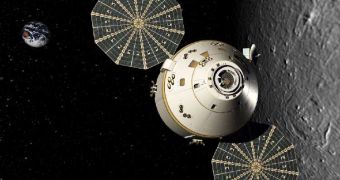We all know how valuable heat shields are while making re-entries into Earth's atmosphere, the Columbia space shuttle disaster stands as testimony for the importance of such hardware, as a hole only about 30 centimeters in diameter brought down a 3.6 ton behemoth of a spacecraft, killing seven in the process. In fact, the heat shields of the U.S. space shuttles are rather weak in comparison with those of the new Orion space capsules which will be used in NASA' Project Constellation.
NASA has recently announced that the prototype of the heat shield, which will be equipping the Orion space capsule, has been delivered to the Kennedy Space Center for further testing, in order to determine whether or not it will resist to re-entry maneuvers into Earth's atmosphere, Mars' or to trips between the Earth, the International Space Station and the Moon.
Combining technologies used in the build of the space shuttles and the crew exploration vehicles used during the Apollo program, Orion's heat shield represents the first component developed by NASA in the Project Constellation program. It is only a MDU, meaning manufacturing demonstration unit, specifically created to evaluate the capabilities and the look of the final product, which will equip the real Orion spacecraft.
During testings, the prototype heat shield will be subjected to laser and x-ray scans amongst a series of other tests part of the nondestructive evaluation phase. According to NASA, the prototype measures five meters in diameter, is constructed on the base of the thermal protection system use of the US space shuttles, meaning it is formed of tiles of thermal insulating material, made of phenolic impregnated carbon ablator, or PICA, material rather similar to that used by the Apollo capsules.
The final configuration of the heat shield could contain up to 200 such tiles, capable of protecting the capsule while traveling through the Earth's atmosphere at speeds up to 40,000 kilometers per hour, during which time the surrounding air could heat up the shield to temperatures as high as 2,760 degrees Celsius. But why would NASA replace the TPS tiles used by the space shuttle with a new material, since the thermal protection system has already proven its efficiency?
As it turns out, the PICA material is much more resilient to high temperatures than the TPS. Secondly, PICA has already been implemented in past space missions, such as the Stardust mission which visited the Wild 2 comet in order to return samples to Earth. Note that the heat shield of the Stardust mission consisted of a continuous piece of PICA.
But the ultimate argument, and probably one of the most important, is that, after a mission, the heat shield protecting the Orion space shuttle will be discarded and replaced with a new one, a rather easy task while comparing the 24,000 tiles of the space shuttle with only 200 of the Orion capsule.

 14 DAY TRIAL //
14 DAY TRIAL //